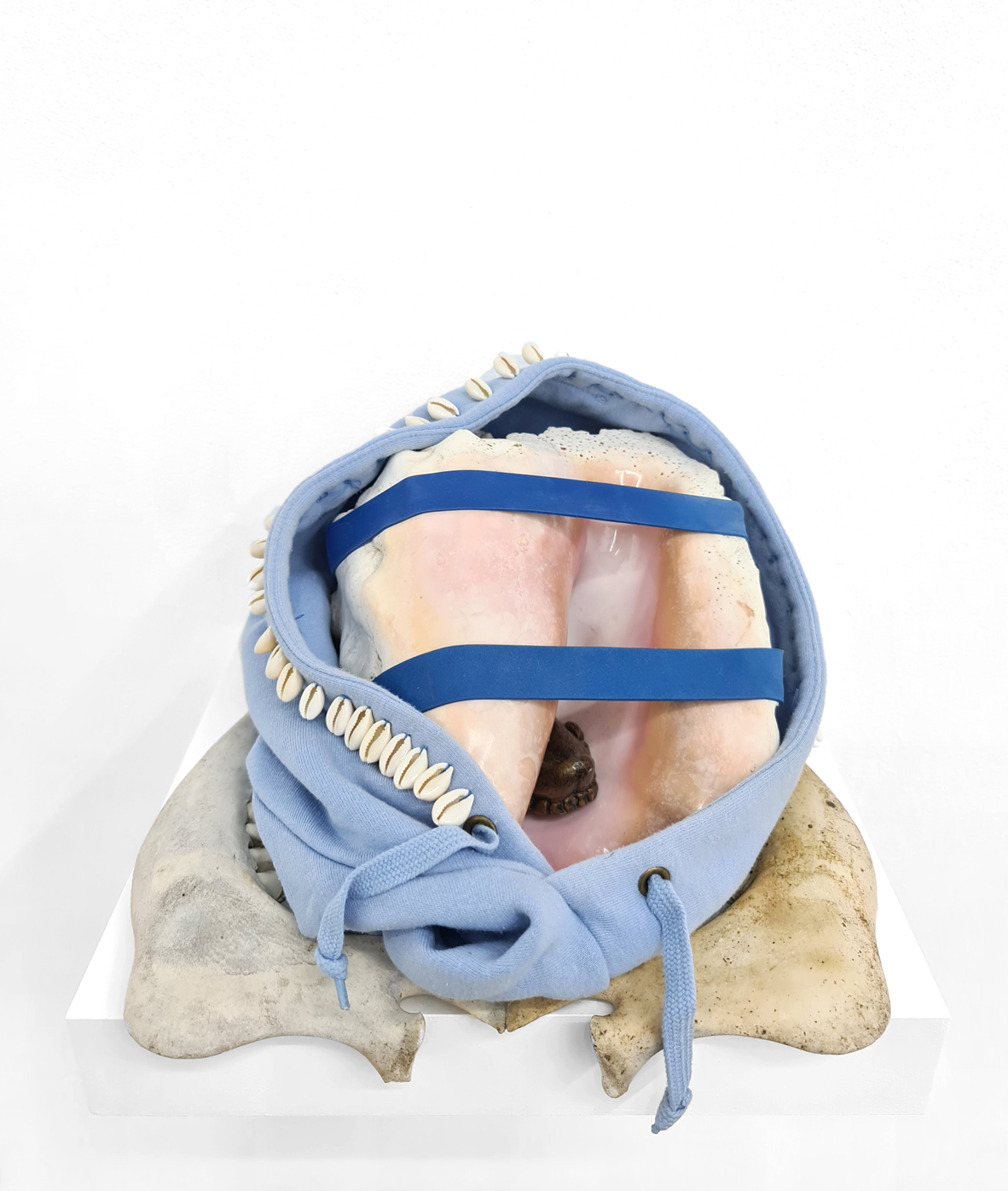


Fiona Banner aka The Vanity Press, Shiraz Bayjoo, Blue Curry, Newell Harry, Himali Singh Soin, Alberta Whittle
Language, identity, ownership within the global post-colonial world are at the heart of this group exhibition at Copperfield Gallery. The title of the show refers to the medieval practice of depicting dragons on unfamiliar areas of maps. It stands as a reference to our bias and the need to unlearn colonial attitudes that underpin the way we live.
Alberta Whittle's Palavar (2019) comprises a large pink conch shell with a bronze tongue, perhaps a lost mother tongue. Tight blue rubber bands seem to hold the shell together, wrapped in a light blue hoodie decorated with cowrie shells. The whole composition sits on the jawbones of a cow. On the wall above sits a mouthless mask, signalling the impossibility of talking about difficult truths.
The objects have different meanings. The beautiful conch reminiscent of the Caribbean Sea was used to give signals of rebellion in plantations. The blue band refers to the rubber plantations of Barbados. The jaw of a ruminant animal refers to mastication, a term used to describe the first process of making rubber while also referring to the importation of sheep and cows to the Caribbean.
The term 'palaver' originates from the Portuguese "palavra", meaning "word". In many parts of Africa it refers to the custom of conflict resolution, bringing together separate parties to talk and thrash out a compromise, adding in a layer of complexity with the legacy of the slave trade. The mask above refers to the artist's individual and ancestral traumas and experiences; the difficulty of forging an identity within the complexity of being many things at once.
Shiraz Bayjoo’s Politique des Races (politics of race) part three (2019) explores Madagascar’s history with the slave trade and the fight for independence during the Second World War. On the left-hand side stand three women, queens of the Sakalava nomadic kingdoms of northern Madagascar, which had slave trading networks with the French East India company. On the external panels two black soldiers on horses stand slightly behind two white French officials; oppressors and oppressed standing together and further complicating the complexity of resilience, race and identity. Lemurs and Water Bananas are represented on the sides of the panel. Endemic to Madagascar, these were often eaten during famines and wars. the natural elements that are represented in this work stand as a sentient witnesses of oppression and resistance.
Nature is central to Himali Singh Soin’s video we are opposite like that, 2019 which explores Victorian England’s fear of the return of a glacial epoch. It mixes early footage of the Arctic with images taken from Victorian magazines, together with a poetic reading and a soundscape by a string quartet. Images of polar bears invading parks and a frozen Thames under London Bridge force humans away from the city. “For historians, the present has lost itself over time” says the voice, referencing a “distance from one another” – and distance from our land in the current climate crisis.
A small scall sea painting by Fiona Banner aka The Vanity Press plays with the traditional grandeur of traditional seascape paintings. Banner presents a humble depiction of the sea, Full Stop Seascape: Kagena (fallen), 2019. The stop in the middle of the sea stands both as a border and a point of arrival for migrants that choose to cross the Mediterranean, infusing the sea with political implication.
The violence and agitation of migration is expressed at the opposite end of the gallery with Newell Harry's Untitled (Palm Island Coconut / Rough), (2011), a woven pandamus carpet typical in the Southern Pacific islands. While the first part of the title refers to elements expected by mass tourism, the second part of the work, rough, gives a violent addition, accompanying dislocation and exchanges and creating a dialogue with the loaded works of Bayjoo and Whittle.
Barbados, Madagascar and the Pacific Islands could be the location of Blue Curry's Untitled. Swimsuits, shower heads (2019), an installation of 12 hanging bathing suits. This work refers to stereotypes of tourism, anonymity and avid consumption. The work also hints to all of those working within the tourism industry who have been affected by the Covid crisis and the insurmountable inequities of the modern world.
Ilaria Puri Purini
Curator of Programmes
Copperfield, 6 Copperfield Street, London SE1 0EP. Open Wednesday-Saturday 12.00-18.00. Exhibition continues until 28 May 2021. www.greengrassi.com